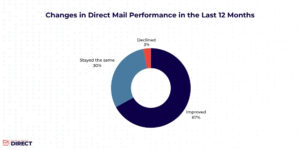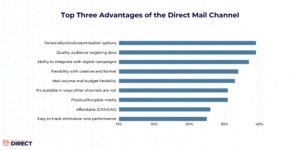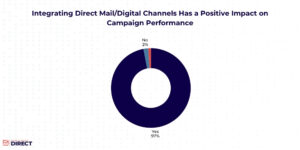Same Experts. New Name.
SeQuel Response and FM Engage are now Franklin Madison Direct. While our name has changed, everything else remains the same: our people, our process, and our passion for driving measurable results through direct marketing.

Blog
Reflecting on the first half of the year, it’s clear that 2025 direct mail campaigns are creating new momentum. As brands adjust to shifting consumer behaviors and rising expectations, direct mail continues to prove its value as a reliable, high-performing channel.
Our Direct Mail Industry Benchmark Report is a valuable resource for consumer behavior and industry trends. It examines B2B and B2C brands’ tactics for engaging consumers through direct mail marketing, drawing from extensive marketer and consumer surveys.
We’re sharing an exclusive first look at insights from the 2025 report that we just couldn’t wait to share. Keep reading for a sneak peek at mail performance and consumer sentiment, plus insights on how you can adapt your direct mail strategies to align with consumer expectations.
| Prefer to listen? Check out our podcast The Direct Effect: Are Your 2025 Direct Mail Campaigns Aligned with Consumer Expectations? |
Marketers feel confident about direct mail’s performance, and the data backs them up. 67% of marketers report improved direct mail results compared to 2024. For many brands, mail outperforms other channels in driving responses, especially for top marketing objectives like customer acquisition.

Our research also shows that direct mail is now the second most influential advertising channel, trailing only television/video streaming services. Yet 44% of consumers say they need to receive two to three mail pieces from a brand before they are ready to respond.
Marketers relying on one-off mailings may miss the opportunity to build buzz and a strong foundation for growth. Consider whether your 2025 direct mail campaigns are set up for sustained impact.
For example, a hearing aid manufacturer partnered with Franklin Madison Direct to implement the FactorTest methodology for the brand’s initial mailing. The knowledge gained during an eight-month testing period ultimately led to the creation of an evergreen program that rapidly increased from 50,000 to 500,000 pieces. The brand experienced notable performance enhancements, including a 25% decrease in CPA/CAC.
In our latest research, 39% of marketers say that the ability to personalize messaging is their top reason for investing in mail. Consumers agree, as 23% of consumers report that personalized elements are the main factor that creates a positive impression of a direct mail ad.

Yet, nearly half of consumers admit that irrelevant or poorly timed mail frustrates them. That is why genuine personalization goes beyond simply adding a first name to consumers’ mail. Here is how you can maximize mail’s impact throughout the buyer journey:
Whether your goal is to acquire new customers or retain existing relationships, partnering with a direct response agency ensures you can develop a performing program and make your audience feel understood when they need it most.
Marketing channels should not operate in isolation, and direct mail is no exception. Brands that integrate offline and online channels see measurable performance lifts. In fact, 97% of marketers report boosted performance when mail is paired with digital touchpoints like display ads, email, or SMS.

Consumer preferences align, but only when the experience feels seamless. Our research found that 38% of consumers are more likely to engage with a brand when they receive both mail and digital ads, provided the messaging and creative are consistent. Disjointed campaigns dilute your impact, while integrated campaigns amplify it.
Landing pages are a key piece of this puzzle, serving as the bridge from physical to digital. When your mail, emails, and online experiences tell the same story, your brand feels cohesive, and consumers notice. As you plan the rest of your 2025 direct mail campaigns, consider how a multichannel strategy might reinforce your marketing message.
The mail channel is driving action, and consumers are engaging. Brands that take the time to align their strategies on frequency, relevance, and integration will see the greatest return in their 2025 direct mail campaigns. The 2025 Direct Mail Marketing Benchmark Report is available for download at https://franklinmadisondirect.com/e-books/direct-mail-report/.
Want to ensure your direct mail campaigns are set up for success this year? Stay tuned for the full report or connect with a strategist today to start optimizing your program.